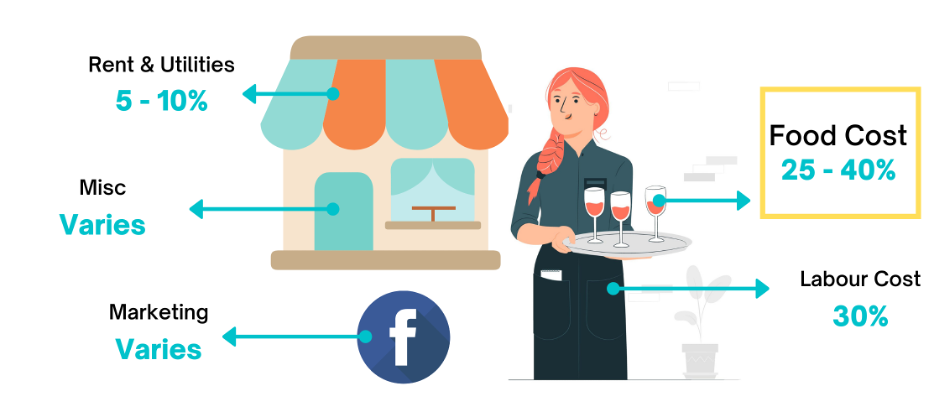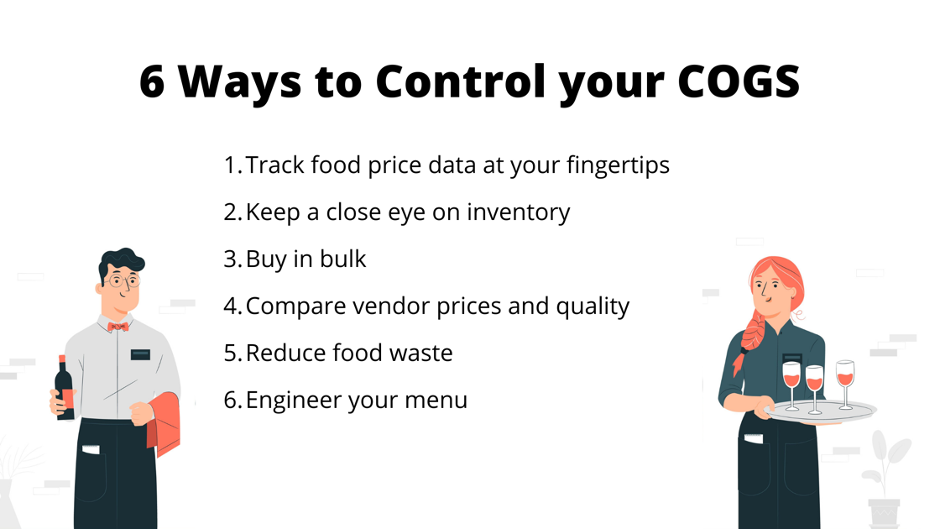6 Ways to Lower your COGS (Sponsored Post)
5 Min Read By Food Razor
Cost management is an essential skill for all restaurateurs. For restaurants and cafes, letting your Cost Of Goods Sold, or COGS, run out of control is a kiss of death for the business, because COGS will directly impact your profit margins and inventory. Businesses with little to no inkling of how they’re handling their COGS often find themselves in a pickle because they're unaware of their restaurant/cafe's financial health and performance.
What exactly is COGS?
COGS is essentially the total cost of all the ingredients that a restaurant/cafe uses to create menu items, given a time period. Industry-wide, an estimated one-third of a restaurant/cafe’s gross revenue is dedicated to paying off COGS. COGS alongside other spending areas like staffing, utilities, rent, etc are taken out from your restaurant/cafe’s gross revenue to work out your net profit.
Restaurant Industry Costs

Since factors like seasonality directly affect availability and the cost of ingredients, your COGS will be affected as well. Best practices come with being vigilant when it comes to COGS patterns, routinely monitoring them, and being able to make efficient business decisions with this information.
6 ways to lower your COGS
To make things simple: the lower your COGS, the higher your restaurant’s profit margins. Regardless of whether you’re operating a single outlet cafe or a chain of restaurants, it is key to find methods to lower your COGS without sacrificing food quality or jeopardizing the customer's dining experience.

1. Track food price data at your fingertips
Knowing how much your food prices are daily, gives you so much information and power to make efficient business decisions. Empowering yourself with the knowledge on whenever food prices are high or low and when they’re increasing or not, gives you a multitude of options that can influence the way you handle your restaurant/cafe business. Having an overarching view of unit prices is the first step to managing your COGS more comprehensively. Use a solution like FoodRazor to easily track your food prices or manually do so through comparing spreadsheets. Being vigilant in this aspect creates more opportunities and areas to reduce costs like menu engineering, changing suppliers, buying in bulk, etc. At the same time, you will gain greater visibility of your business' current financial health.
2. Keep a close eye on inventory
You won’t know exactly how much inventory and food supplies you require unless you closely track each menu item’s sell-through. An interesting thing about COGS is that regardless of how much you’ve sold, you can still incur high COGS. However, being cautious not to over-purchase stock and only buying the average needed to sell, can help you to minimize additional costs and wastage.
If your establishment has yet to implement proper back-of-house workflows or procedures in place, you could be losing lots of money due to inventory spillage. Careless portioning, over-ordering, and food waste can take a huge toll on your restaurant's COGS. Look at your current sales reports and calculate how much supplies you require to meet the demand for your menu items. Match these values with your current spending on ingredients and you’ll be able to know if this is properly balanced.
If this process sounds too manual, an inventory function integrated into your order creation can save you hours and unspeakable amounts of effort. With this, there’s no need to accommodate how every supplier wants to be contacted. Your orders and invoices can be tracked without discrepancies and misplaced paper invoices will no longer be a problem. Tracking your inventory through invoices is a lot more accurate as it reflects exactly what was delivered. Managing your supply and food inventory requires diligence, but when done correctly, you can effectively minimize food waste and save money.
3. Buy in bulk
Some suppliers offer special prices and discounts to restaurants that bulk purchase their goods. Do take note: When purchasing non-perishables (food with a long shelf life) or ingredients that your restaurant sells quickly (menu items with a fast turnover), purchasing in bulk is a very effective way to get what you need at low prices and lowering your COGS.
A common concern for purchasing food in bulk is that the freshness of food, as well as storage space, could be compromised, since not every establishment has a big enough storage area to keep large amounts or have a fast enough turnover to avoid food waste or spoilage. Always ensure that you only purchase the volume that has a guarantee that they can be sold before spoiling.
4. Compare vendors
While working with suppliers, it’s pivotal to see whether one’s food quality and pricing matches up against another. It’s in the best interest of any restaurateur to compare the pricing of various vendors. If one is offering a cheaper price than another and can assure similar food quality, why not consider switching?
How this comparison can be done depends largely on whether you have a system in place generating reports based on how much volume you are purchasing per supplier and how much you are spending on them. This could be through using invoice management tools to look at the overall volume and amount spent and even down to product item level per supplier. If your restaurant has yet to adopt such technology, you could manually create spreadsheets and compare them as well, though it might be more tedious with formulas and data-entry.
5. Reduce food waste
Regardless of how accurately you are tracking your inventory, there will always be food waste and it is always a big contributor to high COGS. While food waste cannot be entirely eliminated, it can be minimized.
For instance, if you have produce that is turning bad soon, look for alternative creative methods to incorporate them in other forms or in other menu items to create special seasonal dishes. This could be a promotional piece as well for your establishment and you could pump up marketing efforts based on that.
6. Engineer your menu
Your menu’s design has a huge impact on what kind of menu items your guests may order. Right from the kind of layout you choose to the colours used for the menu and the description of each food item, they all play a great role in guest’s decision-making.
Menu engineering is essentially strategically designing a menu to encourage guests to purchase high-profit margin menu items. By creating a menu using menu engineering tricks, restaurants can indirectly influence which items customers are drawn to with one look, increasing sales of the menu items that can rid away razor-thin profit margins.
Conclusion
It doesn’t matter what type of establishment you run, the main goal of achieving the ideal balance between COGS and food quality is inherently crucial for the profitability of your business in the long run.
With the points we made earlier, controlling your spending on COGS is well within your means. Regardless of whether you work with cheaper vendors, buy in bulk to obtain highly discounted pricing, or even revamp your menu items, there are a multitude of options to lower your COGS and increase profit margins.
These tasks can get even easier with the adoption of technology to handle the tedious number-crunching. While you carefully plan and pay attention to the details of each report generated, know where you’re spending the most on, and pinpoint where to tackle, greater profits are coming your way.

